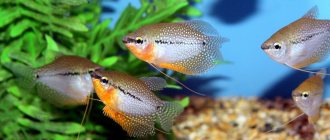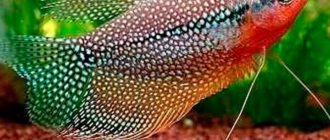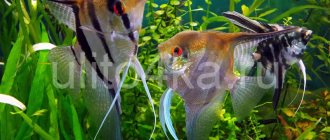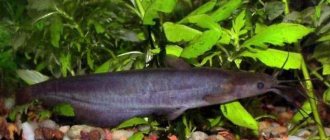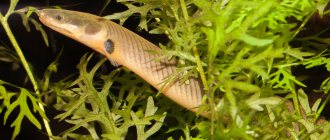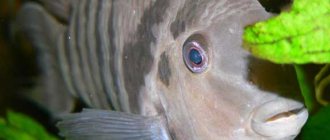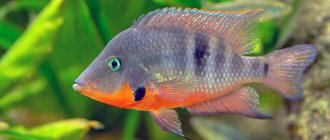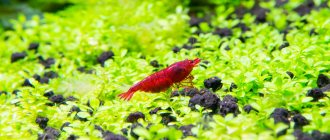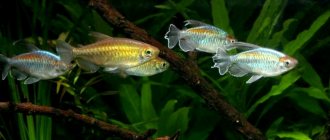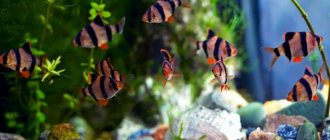Fish
Gourami belong to the labyrinth family of fish. They have an additional special organ that allows them to breathe not only in water, but also in atmospheric air.
Gourami have an unusual appearance, thanks to which they are appreciated by lovers of original aquarium fish. But this is not their only positive quality.
Gourami have an extremely peaceful character and get along with many other species, and if they conflict with someone, the aggression does not come from them.
Description of gourami
Gourami belong to the family osphronemidae or macropods and differ from other species in that they have the ability to float to the surface of the water and breathe air, thanks to a special organ - a labyrinth located in the epibranchial part of the head. The second, infrequently mentioned name is thread-carriers (the ventral fins of fish resemble long threads that serve as an organ of touch).
Several species found in nature and bred through selective breeding are bred in aquariums. The lifespan of fish, with proper care, is 8-10 years.
The spotted or common gourami (trichogaster trichopterus) most closely resembles its ancestors.
Content Features
The most suitable living conditions for gourami would be to recreate their natural biotope. In Southwest Asia, these fish are found in shallow waters with an abundance of vegetation and rotting organic matter. That is why they have such developed pelvic fins, reminiscent of long thin tentacles, and atmospheric breathing. In the aquarium, labyrinths do not require aeration at all. They prefer old water, so frequent changes are not necessary.
Don't forget to set up the appropriate fish habitat
Since the fish are tropical, the water temperature must be maintained in the range of 24−26°C. The acidity level should be 6.5−7 pH. It is desirable that the soil is dark in color. The lighting should be bright and located on top, not on the side of the aquarium. In such conditions, gourami acquires the most saturated color and looks very impressive. Under good conditions, these representatives of the labyrinths are able to live in captivity for up to 7-10 years.
In this video you will learn more about gourami:
Compatibility with each other
The minimum compatibility of males is a proven fact. Females are peaceful and never bully underwater inhabitants. Males often show aggression towards each other in an aquarium full of gourami, regardless of species and color. Natural rivalry forces them to engage in fights with relatives in order to protect territory and gain the favor of females.
Representatives of one species get along well in a large reservoir, which they divide into sections and live, with a sufficient number of females, without crossing the boundaries of the selected territory.
Feed and feeding
Aquarium fish, marbled gouramis, are omnivores; in the wild, their ancestors feed on crustaceans, insect larvae and zooplankton. In an aquarium, these fish will typically eat all types of fresh live, frozen foods and dried flakes. To balance the diet, gourami should be fed high-quality dry flakes and pellets as the main diet, and for variety, add tubifex, bloodworms, brine shrimp and any other suitable food to the food. You can also offer fresh vegetables, such as blanched lettuce.
Feed once or twice a day.
An interesting thing about spotted gouramis is that they are known as hydra eaters. Hydra is a miniature aquarium pest with poisonous tentacles. Hydra is capable of capturing small fish and paralyzing them with poison, and then holding them with its tentacles until it eats it. If hydra bothers you in your aquarium, get a gourami.
Neighborhood with other fish
Despite intraspecific aggression, gourami are quite peaceful and calm and can coexist with many aquarium inhabitants without problems.
Important conditions for peaceful living are as follows:
- an aquarium with a volume of more than 100 liters, including all the fish living in it;
- presence of plants;
- neighbors are selected of the same size, since small fish can easily turn into food for larger individuals.
Gourami get along well with almost all varieties of peaceful fish.
Gourami get along well with all the peaceful inhabitants of the aquarium. But they can eat small fry of viviparous fish, coil snails and their eggs.
Soma Corydoras
All varieties of corydoras, which include panda, speckled, golden, and leopard, are convenient neighbors, indifferent to other types of fish. Catfish lead a bottom lifestyle and almost never encounter gouramis, which live in the middle and upper layers of water.
Angelfish
Angelfish are calm and unobtrusive, they get along with all inhabitants, but only if the reservoir is spacious enough and not densely planted. In tight spaces they can be aggressive.
Labeo
Territorial owners only pick on fish with bright colors, seeing them as rivals. They do not conflict with other fish that live in the middle and upper layers of water if they are given enough water space.
Swordtails
Permanent inhabitants of almost all home aquariums, swordtails often compete with each other and chase small fish. They coexist peacefully with larger fish.
Rasbory
Cute rasboras, although predators, are valued by aquarists for their non-conflict nature and coexist peacefully with all varieties of fish, especially small ones.
Danio
Very active fish. They get along with almost all aquarium inhabitants, including gouramis. They live in a flock of up to 30 individuals.
Pecilia
The compatibility of platies with other fish is quite high. They exist peacefully with non-aggressive small and medium-sized individuals. There are about 130 species of these colorful fish.
Botsiya
They are fussy and can show aggression, so you need to choose neighbors for them carefully. It is better to add young fish to the aquarium so that the fish “get used to it”, then there will be no problems with them.
Mollies
Moderately friendly, they get along well with peaceful inhabitants of the home pond, especially with female neighbors and the same size as them. In a cramped aquarium, they begin to terrorize its inhabitants; one mollies need 10 liters of water space.
Tetras
Peace-loving fish living in a school. Lonely tetras can be aggressive, but a flock of 15-20 individuals is a guarantee of peace for all underwater inhabitants.
Catfish plecostomus
Popular residents of home ponds, friendly neighbors who get along with all species, even extremely aggressive ones, as they lead a bottom-dwelling lifestyle. They are considered the best aquarium bottom cleaners.
Rainbows
Small schooling fish that got their name because of their bright colors. Ideally coexist with all fish, except predators.
Habitat in nature
Since the marbled gourami is an artificially bred fish, it cannot be found in the natural environment. But the ancestor, the blue gourami, whose distinguishing features are invisible, is found in the Asian part of the planet. Can be seen in lowlands. Prefers still and slow waters. Chooses a place without a current, but with a large number of plants.
During the rainy season, it moves from rivers to floods, and returns in dry times. Under natural conditions, the fish eats insects and plankton.
The history of the aquarium species begins with the breeding of the Blue Gourami fish by breeder Cosby. At first, the marbled gourami was called by the man’s surname, but later acquired its modern name.
Limited compatibility
It is difficult for phlegmatic fish to coexist with overly active individuals or fish that are much larger than them.
Barbs
Hyperactive and cocky, if there are few plants in the reservoir, they can pluck their neighbors’ tails and fins. They are not afraid to pester even individuals that are larger than them.
Guppy
Viviparous, nimble fish can get along with slow-moving species if they grow together from childhood. Gourami get used to the flickering flock of guppies and do not pay attention to them.
Loaches
They live on the bottom, but can pinch the tails and tear off the fins of the most phlegmatic individuals. Often they drive away aquarium inhabitants from food that has fallen to the bottom.
Discus
Very large neighbors for small fish. They can destroy all small species, mistaking them for live food.
What type of aquarium is needed?
Fish need to create conditions that resemble their natural habitat. An aquarium for 3 or 5 individuals should have a minimum volume of 40 liters. The more fish, the larger the container should be. Pour in warm and not hard water. Temperature is from 24.5 to 28.5 degrees, hardness is 9-20 pH, and acidity is from 6.50 to 7.50 dH.
Select the soil in dark tones, the fraction is not important. Plant more vegetation in your aquarium, but be sure to leave room in the middle for the gourami fish to move around. You can use, for example, cryptocorynes, cirrus, and Thai fern. Plants help fish calm down and have privacy.
We recommend reading
Tarakatum catfish: care, maintenance and compatibility
Also, install a variety of hiding places in the aquarium for swimming fish. Driftwood, stones, clay pots and coconut shells are suitable for this purpose. Place any floating plants on the water, for example, watercolor, riccia, pistia. If there is a lot of algae and hiding places in the aquarium, the fish do not experience stress, because in their homeland they live in muddy, shallow water. They can rest peacefully in thickets of plants.
Absolutely incompatible
Gourami cannot get along with large fish, predators and aggressive species that conflict with each other and other fish.
Neighborhood is completely excluded:
- cockerels;
- goldfish;
- koi carp;
- astronotuses;
- African and South American cichlids.
Giant Astronotus are completely incompatible with gouramis and other small varieties.
How do fish build nests?
Before breeding, males build nests from bubbles and particles of aquatic plants. Fertilized eggs are subsequently placed there. Females do not care for eggs or fry. All responsibility for the laying lies with the father. He looks after her until the fry emerge and begin to swim on their own. Then his paternal instincts weaken and he swims away.
Fish are bred in small spawning grounds with a capacity of 10-20 liters, temperature 24°C-26°C. Spawning duration is 4 hours. At this time, the future father takes care of himself and tries to “lure” her into the nest. The spawned fish is immediately removed from the tank back into the general aquarium, otherwise the father will begin to offend it.
The incubation period lasts 24 or 48 hours, after which the larvae appear. When the offspring begin to hatch, the male is removed from there. Hungry, he can snack on the children (he is not fed during this period of time).
After 3 days, the larvae turn into fry and begin to swim independently. They are fed with ciliates or sifted “dust”. Babies are raised in a separate container for 2 months. Only then are they ready to move into the “dormitory”.
Kinds:
In the scientific classification, six species of Gourami have been identified, but over the long experience of the aquarium industry in keeping and breeding these fish, many new breeding varieties and breeds have emerged. Here are just a few of them.
Kissing
Helostoma temminkii belongs to the Helostomaceae family. This fish is very popular among aquarists because it has an amazing appearance and unusual behavior.
Ichthyologists discovered this natural variety back in the century before last, but breeders from Florida learned to produce offspring of the Kissing Gourami only in the 50s of the last century.
The variety received its name for its expressive large and clearly defined lips. They are strongly protruded and “ready to be kissed.” In addition, two individuals often connect with their mouths. That is, these fish really kiss, maintaining the hierarchy in the school with the help of tactile contacts.
In nature, they are common in Thailand, Indonesia, Sumatra, Borneo, Java, Cambodia, and in any shallow reservoirs with weak currents and rich plant flora.
The natural color is pale greenish-gray. The dimensions are about 15-17 cm. The structure of the lips is also surprising in that on their inner side there are small teeth, with the help of which the fish scrape algae from any surface.
Pink
The full name of this variety of Helostoma temminkii is Pink Kissing Gourami, as it is not a natural species, but bred from the Kissing Gourami.
In these individuals, unlike the progenitor, the body has a more round shape, but its dimensions are smaller, up to 12-13 cm. The color is pinkish or with an orange tint. The structure of the lips is characteristic - they are large and extended forward, as if in readiness for a kiss.
Pink Gourami are hardy and unpretentious to the conditions, but they are still large for the beginning aquarist, since each fish requires about 100 liters of water. And the character of these pets in adulthood becomes not very peaceful, and their breeding is quite problematic.
Blue
Trichopodus trichopterus are inhabitants of South Asian and Indonesian freshwater areas. This variety of Gourami can be found in slow-flowing rivers of Vietnam, China, Cambodia, Laos, Myanmar, Malaysia, Thailand, the Philippines, Taiwan, Papua New Guinea, the Seychelles, Namibia, and Colombia.
The species has many color isomorphs, some of which have been selectively bred.
The body measures 9-15 cm, it is colored whitish-blue with uneven spots. There is also a brown natural variety.
This omnivorous fish is distinguished by the fact that it eats hydra parasites, which are extremely dangerous for the inhabitants of artificial reservoirs.
All variable varieties of Blue Gourami are closely related to wild ancestors, and therefore are distinguished by excellent health. They reproduce well in captivity.
Lyalius
According to the scientific classification, Trichogaster lalius is also a Gourami, as it has labyrinthine breathing and a similar body structure.
This bright, unpretentious fish grows up to 8-9 cm and is suitable even for beginner aquarists.
Initially they were found only in Asian reservoirs, but are now common in America.
The body and fin plumage are colored in multi-colored stripes from greenish to red and orange.
Schooling fish with a clearly defined hierarchical structure. They reproduce well in home aquariums.
Fiery
Gourami or Lyalius of this variety are bred only artificially. They grow up to 7-9 cm, the body is painted in a bright orange fiery color, the plumage on the back is blue.
A bright and unpretentious fish, suitable for beginners.
Gigantic
Osphronemus goramy is the largest representative of Gourami, growing up to 70 cm in its natural habitat, but in an aquarium it reaches only 40 cm.
The species was originally discovered in South Asian slow-flowing water bodies and was used as a commercial fish by the indigenous population; now it is also found in South America and Australia.
The omnivorous large fish even eats frogs and dead mammals.
As they age, males develop a fatty lump on their forehead. The color is light with dark transverse stripes, but with age they fade and the color becomes monochromatic. The pelvic fins, like all Gourami, are thread-like.
In aquarium farming, artificial coloring of fish using chemical injections is widely used, but this significantly reduces the life expectancy of an individual and is condemned in developed countries.
The fish is schooling, but in an aquarium it lives well in a male-female pair. Males often enter into competition with each other, especially when young.
They breed well in captivity, but a large spawning tank is required.
Red-tailed
Osphronemus laticlavius is also a giant species; even in an aquarium, the length of an adult individual reaches 50 cm. Therefore, for home keeping, a tank of 600-700 liters is required, and ichthyologists practically do not try to breed this variety of Gourami in captivity. Sexual dimorphism is almost completely absent and it is impossible to determine the sex, and it is very difficult to populate a flock of at least five specimens.
But this pet has the most colorful colors. The body color is green-blue, and along the edges of the fin plumage there is a fiery border. With age, all scales and fins may turn red.
It lives in slow-flowing rivers of Asia, Malaysia and Indonesia.
Gold
Trichopodus trichopterus is a selective species bred artificially from the Blue Gourami. The pet grows up to 14-15 cm, has a rich golden color, and is unpretentious and easy to breed. Just like the wild ancestor, there may be dark markings on the body.
Honey
Trichogaster chuna is so named because of its bright, rich coloration in yellow and silver-gray tones. Moreover, it is expressive, although different, in representatives of both sexes, but in the male it becomes even more intense during the mating season.
The fish is small, up to 4-5 cm, schooling, very similar to Lyalius. In an artificial reservoir it behaves very timidly and shyly.
The variety is widespread in the Far East. This fish has a very interesting way of feeding. It spits out a stream of water from its mouth, knocking down insects in flight or from branches, shrubs and trees growing near a pond.
Lunar
Trichogaster microlepis are very beautiful, although their color is dull. The small scales are white, almost transparent, but highly reflective. In low light they glow like moonlight.
They live in the reservoirs of Thailand and are called Pla Kadi Nang by the local population. The last word means "female", as this fish was long considered to be the female Blue Gourami. Also found in Vietnam and Cambodia, in the South American Mekong.
With age, the back of the fish acquires greenish tones, and the iris of the eye turns red. The fin plumage of males has the same shades; in females it is pale.
Neon
Trichogaster lalius is an artificial species bred through selective breeding. This is the most famous modification of Lyalius in the aquarium hobby.
The body of small (7-8 cm) fish has a more rounded shape, thread-like pelvic fins are preserved. The main color is a combination of bright multi-colored transverse stripes from turquoise and blue to burgundy shades.
Marble
Trichopodus trichopterus is a breeding variety of Gourami obtained by crossing Blue.
An adult individual grows up to 12-13 cm, has high fin plumage, colored, like the body, in pale blue tones with sparse dark markings and a small scattering of white spots. The color resembles a marble pattern.
Easily reproduce in home aquariums.
Macropods
Macropodus opercularis is also called Paradise fish and is considered one of the most beautiful aquarium pets. These are inhabitants of reservoirs in Southeast Asia with weak currents; their homeland is Thailand, China, Vietnam, Cambodia, Japan, Malaysia, and Taiwan. The species was brought to Europe in the mid-19th century.
They grow in an artificial reservoir up to 10-11 cm. They are distinguished by pointed fin plumage with a large tail. The color is often bluish, with transverse red stripes.
These are omnivorous and hardy fish, behaving quite aggressively in the aquarium. They reproduce easily, but you should watch especially the male during spawning. The male often, protecting the offspring, even beats the female.
Varieties are also known:
- Black Macropod. It lives mostly in Indonesia. It has an almost charcoal body with red fin plumage.
- Round-tailed. This fish grows to only 7-8 cm, its body is also dark, tinged with green, and there may be a red border on the fin plumage. The tail is rounded and very large.
Pearl
Trichopodus leerii is the most peaceful of all Gourami species, growing up to 10-12 cm in length.
They got their name from their original coloring. The main background is light brownish or reddish, with small specks of pearls scattered across it. A patterned border extends along the back to the tail.
The species was discovered in the century before last in Asia. Lives in bodies of water with slow currents in Thailand, Malaysia, Borneo, Sumatra.
The natural population has now greatly decreased, but mass production of fish for the aquarium hobby operates in Europe and the Far East.
They reproduce easily in home tanks.
Platinum
Trichopodus trichopterus is a selected species of Blue Gourami that does not live in natural conditions, although the aquarium variety is unpretentious and hardy.
Pets grow up to 12-13 cm. They are similar to the wild ancestor, but the main background is snowy with a yellowish and silvery tint. The back, belly, and fin plumage are more heavily tinted, with dark markings remaining at the tail and along the midline.
Snakes
Trichopodus pectoralis is a large natural species (15-20 cm) that lives in south-eastern natural reservoirs with weak currents. Distributed in Cambodia, Vietnam, Malaysia, Philippines, Indonesia.
The name is determined by the remarkable color in yellowish and brown tones, patterns reminiscent of snake skin.
Thick lips
Trichogaster labiosa or Labios is a small fish (about 9-10 cm) slightly reminiscent of the Golden Gourami in color.
At first, this species lived only in Asia, but already in the 19th century it was distributed throughout South American waters. The main color is orange or yellowish-brown, males with vertical turquoise stripes. Females are paler and the lines of the pattern are almost invisible.
Peaceful appearance, easy to breed.
Grumpy
Trichopsis vittata - small Gouramis (6-7 cm), living in slow-flowing reservoirs of Vietnam, Laos, Cambodia, Thailand, Malaysia, Indonesia, were also brought to America.
The main background of the body is grayish or brown, there are black longitudinal lines. Males have purple plumage with burgundy markers.
Dwarf
Trichopsis pumila is often called Pumils. This is a small fish (3-4 cm), which is very unpretentious and easily reproduces in captivity.
This variety of Gourami originated from Asia and lives in the rivers of Vietnam and Thailand, Cambodia and Malaysia.
The body is pale brownish with a bluish tint, with two longitudinal black stripes. The plumage is patterned with red and blue dots. It is very difficult to distinguish a male from a female; the male has a slightly brighter color and larger fins.
Thoughtful
Ctenops nobilis or Ctenops are very unpretentious in aquarium keeping and grow up to 9-10 cm.
They live in the Indian rivers Ganges and Brahmaputra, and are also found in Nepal, Bhutan and Bangladesh.
A very warlike appearance with a patterned body in brownish and silvery tones with individual markings. Males are distinguished by red edging on their fins.
Capanuses Dei
Pseudosphromenus dayi is a very calm and peaceful species of Gourami, growing to only 5-6 cm.
In nature, they live in Indian reservoirs, mostly in the foothills of the Western Ghats.
The main background of the body is reddish-brownish, there are longitudinal dark stripes. There is a bluish line along the edge of the fin plumage. Females are paler.
Parosfromenus
This type of Gourami has several varieties. Among them:
- Dark. Parosphromenus nagyi grow to only 3-4 cm, but are very difficult to breed. Endemic to the Malaysian east coast. Males are very bright and warlike. The main background is brownish with two stripes along the entire body. When excited, males turn almost orange and their fin plumage is charcoal with neon bluish markers. Females are much paler.
- Deissner. Parosphromenus deissneri is an endemic species of Bangka Island (Indonesia). Grows up to 4-5 cm. Longitudinal alternating wide stripes of black and yellow colors run along the body. The fin plumage is also colored, but has blue markers. Males become even brighter during spawning. Females are paler.
Labioses
Trichogaster labiosa is a very peaceful variety of Gourami. Natural habitat: Southern Myanmar. In aquarium conditions it grows up to 9-10 cm. Males are slightly larger and brighter colored than females, in blue and orange tones with oblique dark stripes.
Striped
Trichogaster fasciata is also called Coliseum Striped, Lamellar Goura.
They are very simple and unpretentious to keep, easy to reproduce, and suitable for beginner aquarists. They grow up to 8-10 cm and can be kept either in a group or alone.
They are brightly colored in orange and blue colors with stripes and speckles. Females are smaller and paler.
Chocolate
Sphaerichthys osphromenoides grow up to 4-5 cm and are a surprisingly peaceful species of Gourami.
This species has very strong parental instincts, and the main role in breeding offspring in a pair is given to the mother, although usually in labyrinth fish this role is taken by the male.
The homeland of the species is Southeast Asia, Hindustan, Maklaka Peninsula.
The main background of the body is brownish, with transverse stripes of lighter colors located on it. There may be red markers on the plumage (this depends on the habitat of the fish).
False chocolate
Parasphaerichthys lineatus is a very small fish (2 cm), quite pale in color and not very easy to keep and reproduce.
In nature, it mainly lives in slow-moving reservoirs of Myanmar.
The body is quite tall, the male becomes orange in color when excited, and much paler when calm and does not look too much like a true Chocolate Gourami.
Giant chocolate ones
Sphaerichthys acrostoma reach a length of about 7-8 cm in adulthood, their colors are not too bright, and they are not easy to keep.
In nature, they are most found in the rivers of Borneo.
The body is long and narrow, the head is pointed. The background is grayish, the plumage is translucent, the pattern is pale. During spawning, males develop a longitudinal dark stripe.
Belothonia
These fish come in different types. The most common:
- Belothonia Signata. Belontia signata is often called the Sri Lankan Fighting Fish due to its combative nature. Body length reaches 12-13 cm. Endemic species of Sri Lanka. The main background is ruby to ocher in color, the plumage on the tail is uneven and jagged.
- Belothonia Haselda. Belontia hasselti reaches 20 cm in length and has a very unfriendly temper. The homeland of the species is the Greater Sunda Islands, Malaysia, Thailand. The main background of the body is snow-milky with a honeycomb mesh pattern, which becomes very bright during the mating season.
Fish-Crawlers
Anabas testudineus or Anabas, like all labyrinthine species, belongs to the collective name Gourami. The fish is native to Asia, but is now found in both Australian and American waters.
This species is hardy and resilient; it can move on land on pectoral fins and gill covers, using its tail for propulsion.
The coloring of the Pineapple is inconspicuous; in its homeland, the fish is used in fishing.
Individuals grow up to 20-30 cm, with females being larger. The main background is grayish or brownish, there are dark markings, the fins and tail are rounded.
Chameleon Fish
Badis badis are able to change colors and are easy to maintain.
The homeland of the species is Southeast Asia, India, Pakistan, Nepal, Bangladesh, Myanmar, Thailand. They grow up to 5-6 cm, the color is variable - from orange to blue or purple. The color depends on the conditions of the aquatic environment. Males are larger and brighter.
Ctenopomas
Several types of them are known:
- Eight-lane. Microctenopoma fasciolatum is an African variety of Gourami, grows up to 8-9 cm. The main background color is gray or dark brown, it has transverse uneven dark stripes, plumage with a bluish tint.
- Leopard print. Ctenopoma acutirostre also lives in Africa. The color is spotted in brownish tones. The body is high, the fins are jagged. They grow up to 18-20 cm. It is more of a predator, considered conditionally peaceful.
- Sophisticated. Ctenopoma acutirostre is also called Ctenopoma Ansorg. This is a small (6-7 cm) and fairly calm fish, living mostly in the Congo River basin. Males are brighter than females; the pattern consists of transverse wide stripes of gray and orange, which continues on the fin plumage.
Leaf Pisces
Monocirrhus polyacanthus can take the form of leaves that have fallen to the bottom of a reservoir, so they camouflage themselves from predators and while hunting their victims. This is a difficult species to keep and reproduce, distinguished by its interesting appearance and habits.
The homeland of the variety is South America (Brazil, Peru, Venezuela, Colombia, Bolivia).
They grow up to 10 cm. It is better to keep these pets alone or in mixed-sex pairs. The body is narrow, yellowish-brownish, resembling the color of a dried tree leaf. Predators, quite aggressive, feed only on live food during the hunt.
Crestsera paradise fish
Malpulutta kretseri or Malpulutta is named after the Frenchman De Cresset, who was a lawyer, but was passionate about ichthyology.
It is endemic to Sri Lanka and has virtually disappeared from its natural range, but is widely bred in captivity.
Adults grow to only 3-5 cm and are easy to keep and reproduce.
Males are larger and brighter than females. The color is grayish-yellowish speckled with a dark shade. The plumage has a bluish tint and a richer edging.
Ocelathus
Parasphaerichthys ocellatus is also called Ocellated Parasphaerichthys, Dwarf or Burmese Chocolate Goura. A very easy to maintain and reproduce peaceful species, growing only 2-3 cm. They live naturally in Myanmar, throughout the Irrawaddy River basin. They can be kept in an aquarium either singly or in pairs or in a flock.
A related species to the Chocolate Gourami, similar in color but lacking the filiform pelvic fins. The head is large, all plumage is short. In the middle of the body there is a black spot with a golden edge. Females are slightly larger than males, but paler.
Gourami Selatana
Sphaerichthys selatanensis also has another name - Cross Chocolate Gourami. The main background is grayish-brownish, and the pattern is of crosses composed of longitudinal and transverse dark stripes. The body length of adult individuals is about 4-5 cm; in male specimens, unlike females, the lower part of the head is only slightly rounded.
They live in slow-moving ponds of Kalimastan, in the Indonesian province of Selatan, from which they got their name.
Gourami Vaillanta
Sphaerichthys vaillanti is a small fish (4-5 cm) with a peaceful nature and easy to keep. They originate from the western regions of Borneo, but almost the entire natural population has been exterminated.
The body of the fish is high, the head is pointed, the fins on the back and abdomen are long, stretching throughout the body. The color combines red and green colors. Unlike other varieties of Gourami, females become especially bright during the mating season.
Males are pale, grayish-brown, with a pouch of skin under the lower jaw.
Schaller's gourami
Trichopsis Schaller is named after the famous fish exporter Dietrich Schaller, who was the first to bring these individuals to the European market.
Schallers grow up to 4-6 cm, are distinguished by their ability to make peculiar sounds and have a difficult character during the mating season. The rest of the time they behave quite calmly.
In nature, they mostly live in the Mekong River basin in Laos, Thailand, China, Vietnam, and Cambodia.
The color depends on the habitat, it can be blue or yellow. Males are larger and brighter.
